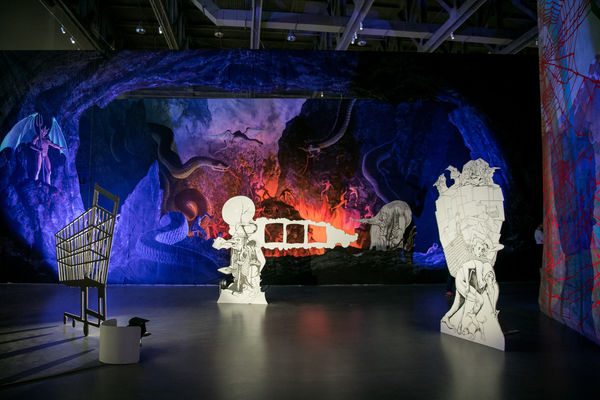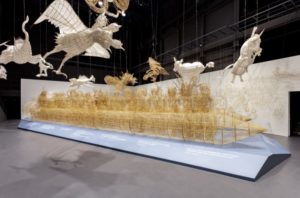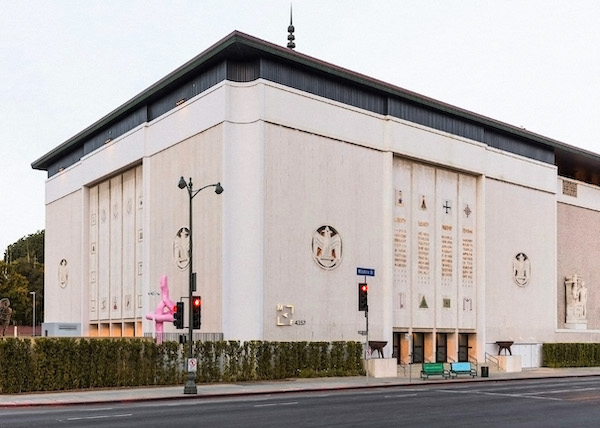The former Masonic Temple on Wilshire Boulevard in Hancock Park has always been an object of fascination—an imposing landmark designed in the modernist style by Millard Sheets in the 1960s, it displays mysterious Masonic symbols etched onto its walls. After the Masons ceased using it in the mid-’90s, the building served as an underground party venue, until the billionaire Guess Jeans owners, the Marciano brothers (Maurice and Paul), bought it for $8 million and renovated it as a repository for their spectacular contemporary art collection. They set up the Marciano Art Foundation (“MAF”) to serve as a tax shelter for approximately 1,500 works from their collection (about 100 works displayed at any one time) and opened it to the public four days a week with no admission charge.

Marciano brothers.
My favorite exhibition was the Jim Shaw show in 2017 with its bizarre wig installation and surrealistically painted theater backdrops. The building reminds me of a high-class mausoleum with its polished terrazzo floor, soaring two-story lobby, mosaic murals and gold-leaf appointments.
The museum was not an instant success. According to inside sources, the attendance routinely ran below 50% of capacity. The only exception was the exquisite Ai Weiwei show which brought in a substantial crowd. The Marciano collection focuses on art created after 1990, with a wide range of work by young artists, including Wade Guyton, Sterling Ruby and Jonas Wood. MAF complemented LA’s three museums focused on postwar art: MOCA, The Broad, and the Hammer. However, it lacked crowd-pulling signature works such as MOCA’s Rothkos and Rauschenbergs or the Broad’s Warhols, Johns and Koons. The MAF’s artists are largely too young to be ensconced in the art pantheon yet.
In 2019, Los Angeles art museum workers began to organize in earnest, including those at MOCA and MAF. Recent years museums have employed mostly young people—oddly classified as “visitor service associates” (VSAs)—and generally paid from $14 to $15 per hour. Art institutions prefer workers with some art education who are capable of answering visitor questions about the collection.
At MAF, many VSAs had MFA degrees. They were required to keep an eye on the behavior of the guests (while MAF hired a security company, it only posted one or two guards per floor). MAF also paid slightly higher wages to docents who led paid guided tours.

Jim Shaw at the Marciano Art Foundation.
At the end of October, the workers formally petitioned MAF for union recognition.
MAF’s response to the workers was delivered November 7 when it fired them all. MAF initially claimed that it was closing its doors temporarily due to poor attendance of its exhibition “Obsidian Ladder,” by artist Donna Huanca, but on December 6, MAF announced that the closure was permanent.
The union, District Council 36 of the American Federation of State, County and Municipal Employees (AFSCME), filed an unfair labor practice (ULP) complaint against MAF with the National Labor Relations Board (NLRB).
On December 23, 2019, a VSA filed a class action lawsuit against MAF on behalf of himself and other workers similarly situated. The lawsuit alleges that MAF laid off 70 workers without the 60 days notice mandated by the California WARN Act, which requires advance notice to workers of a business shutdown. A second cause of action is based on violation of California’s Unfair Business Practices statute. The suit demands 60 days back pay plus benefits for each of the workers, attorney’s fees and costs, restitution and injunctive relief.
The complaint alleges, “Despite the Museum’s purported aim of serving the public and enriching the lives of others, Museum employees—many of whom have undergraduate and graduate-level degrees—were compensated at or barely above minimum wage rate.”
MOCA took the opposite path, issuing a press release (dated the same day as MAF’s shutdown announcement) that quoted its director, Klaus Biesenbach: “We will move forward in good faith to establish an equitable and sustainable contract.” MOCA is now bargaining with AFSCME.

Ai Weiwei at the Marciano Art Foundation.
Ken Moffitt, lead plaintiff in the MAF lawsuit, told me, “There was no evidence that MAF was planning to shut down before the [workers’] petition was presented to MAF.” Moffitt’s attorney, Daniel Rojas, said that there was “no mixed motive for the shutdown. It was based on animus toward the union.” Rojas and his firm also represent the union in the ULP proceeding filed with the NLRB.
Moffitt said that most VSAs were part-time employees working without overtime or benefits. “Wages and scheduling were the main concerns,” said Moffit. “Layoffs would routinely occur between shows.”
Rojas pointed out that back in the 1990s the Marcianos had opposed union efforts to organize workers at Guess Inc.’s Los Angeles garment manufacturing facilities. At first the Marcianos fired the workers, but rehired some after a settlement with the union. Ultimately, Guess decided to shut down in LA and manufacture its garments in Mexico.

Donna Huanca “Obsidian Ladder” at the Marciano Art Foundation.
The lawyer for MAF, Richard Rosenthal, would not comment other than to quote from a statement issued by MAF: “The Foundation and its owners have authorized me to advise you that they are aware of the new CA WARN Act lawsuit and the NLRB charge and believe that there is no merit whatsoever to either claim. However, they do not wish to litigate this matter in the press. They will respond to the claim appropriately when the time comes.”
Art institutions have been taking advantage of the gig economy exemplified by the conduct of such piranhas as UBER. Museums are using highly educated people, paying them slightly above minimum wage, usually on a part-time basis with no benefits or protection. Only by unionizing will these employees have any meaningful labor rights.
What happens to MAF? In order to maintain its tax shelter status, federal regulations permit such foundations to remain closed to the general public, as long as they are pursuing charitable purposes such as loaning art, making grants and making their archives and artworks available for research. However, as I’ve written previously in my column, when collectors set up a family foundation to shelter their collection it seems only fair that it should be open to public view to justify the tax benefits.
Hopefully, the Marcianos will conclude that they should reopen MAF to the public, even on a smaller scale, and let workers unionize. Otherwise, the Masonic Temple may indeed become nothing more than a resplendent private tomb for the Marcianos’ art collection.


